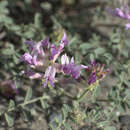Comprehensive Description
provided by North American Flora
Hamosa succumbens (Dougl.) Rydb. Bull. Torrey Club 54; 14. 1927.
Astragalus succumbens Dougl.; Hook. Fl. gor. Am. 1: 151. 1831. Astragalus dorychnioides Dougl.; G. Don, Gen. Hist. 2: 258. 1833. Tragacanlha succumbens Kuntze, Rev. Gen. 948. 1891. Phaca succumbens Piper, Contr. U. S. Nat. Herb. II: 370. 1906.
A perennial, branched below; stems rather stout, flexuose, 2-4 dm. long, hirsute with spreading or retrorse hairs, decumbent or ascending; leaves spreading, 5-10 cm. long; stipules lanceolate to ovate-lanceolate, 1 cm. long; leaflets 13-17, obovate to elliptic, 1-2 cm. long, 5-8 mm. wide, obtuse, hirsute on both sides; peduncles stout, spreading, 3-5 cm. long; racemes dense, head-like; bracts linear-subulate, falcate, about 1 cm. long, pubescent; calyx hirsute, the tube about S mm. long, 3 mm. wide, the teeth subulate, 3-4 mm. long; corolla white or tinged with rose, about 2 cm. long; banner oblong-obovate, retuse; wings fully as long, the blade oblong, with a rounded basal auricle; keel-petals much shorter, the blade broadly lunate, nearly semicircular, with a large basal auricle; pod oblong, slightly arcuate, glabrous, 3-4 cm. long, 5-6 mm. wide and 3 mm. thick, deeply sulcate on the lower suture, abruptly acuminate, inversely Y-shaped in cross-section.
Type locality: Barren grounds of the Columbia, Washington. Distribution: Columbia Valley of Washington and Oregon.
- bibliographic citation
- Per Axel Rydberg. 1919. (ROSALES); FABACEAE; PSORALEAE. North American flora. vol 24(1). New York Botanical Garden, New York, NY
Physical Description
provided by USDA PLANTS text
Perennial, Herbs, Stems woody below, or from woody crown or caudex, Taproot present, Nodules present, Stems erect or ascending, Stems or branches arching, spreading or decumbent, Stems less than 1 m tall, Stems solid, Stems or young twigs sparsely to densely hairy, Stems hairs pilose or spreading, Leaves alternate, Leaves petiolate, Stipules conspicuous, Stipules membranous or chartaceous, Stipules persistent, Stipules free, Leaves compound, Leaves odd pinnate, Leaf or leaflet margins entire, Leaflets opposite, Leaflets 10-many, Leaves hairy on one or both surfaces, Inflorescences racemes, Inflorescence axillary, Bracts very small, absent or caducous, Flowers zygomorphic, Calyx 5-lobed, Calyx glabrous, Petals separate, Corolla papilionaceous, Petals clawed, Petals pinkish to rose, Petals blue, lavander to purple, or violet, Petals bicolored or with red, purple or yellow streaks or spots, Banner petal narrow or oblanceolate, Wing petals narrow, oblanceolate to oblong, Wing tips obtuse or rounded, Keel petals auriculate, spurred, or gibbous, Keel tips obtuse or rounded, not beaked, Stamens 9-10, Stamens diadelphous, 9 united, 1 free, Filaments glabrous, Style terete, Style persistent in fruit, Fruit a legume, Fruit tardily or weakly dehiscent, Fruit oblong or ellipsoidal, Fruit exserted from calyx, Fruit beaked, Fruit glabrous or glabrate, Fruit 11-many seeded, Seeds cordiform, mit- shaped, notched at one end, Seed surface smooth, Seeds olive, brown, or black.

